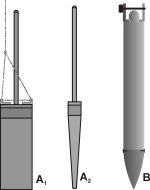Radioactivity Measurements Laboratory
Using Pb-210
The coring equipment
 |
| The probes used for retrieving bottom sediments: A1, A2 - a wedge probe (viewed from the front and from the side), B - a tube probe. |
Sediment cores are gained by the freezing method by means of the flat wedge-probe. The laboratory has a wedge shaped aluminium probe and a cylindrical copper probe.
The probe is filled each time with a mixture of dry ice and alcohol having a temperature of ca -70°C. After gravitational penetration of the sediment to the desired depth, the corer is overgrown by a layer of frozen sediments of thickness 1-3 cm. The thickness of the frozen layer depends on:
- Depth the corer penetrated to - this is because the intensity of heat exchange between corer and the ambient temperature in the sediment depends on the depth. The most intense exchange occurs between the corer and water above the lake bottom, the exchange between corer and sediments is weaker and it decreases downward the sediments. Due to that, the loss of dry ice is the slowest, and the frozen sediment the thickest at the lower end of the corer.
- Time of freezing - it is of the order of 10 - 15 min. This time is not strictly determined - it depends on the depth of penetration and the amount of cooling agent in the corer. The improper setting of the time of freezing, makes the amout of retrieved frozen sediments very small, usually without the topmost section. The proper freezing time was determined by obervation of gas bubbles on the water surface, rising from sublimating dry ice.
After retrieving, the sediment cores are cut into depth-specific segments, melted and placed in hermetic plastic boxes. To falicitate removal of sediment segments, the inside of the corer is filled with warm water.




